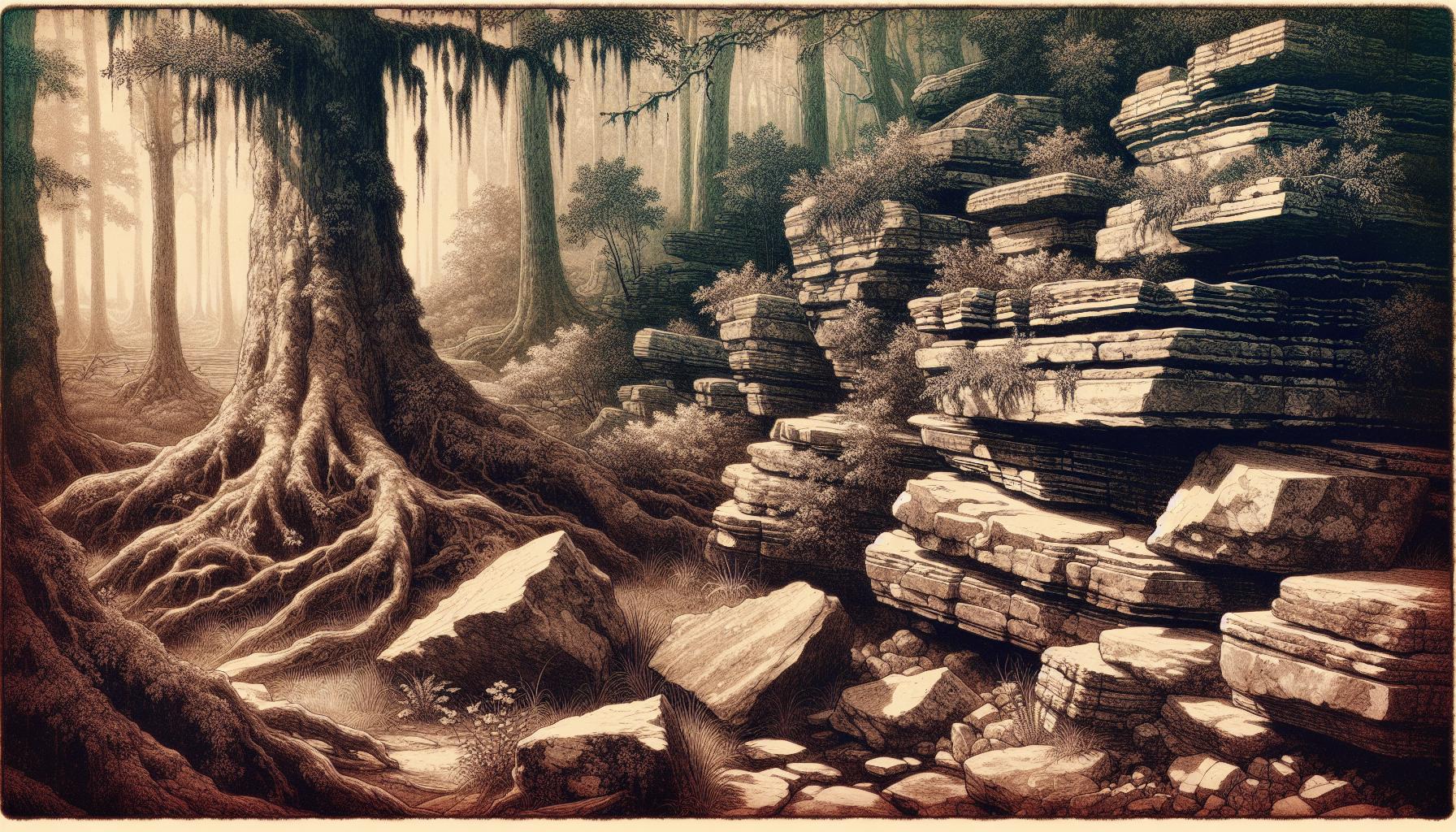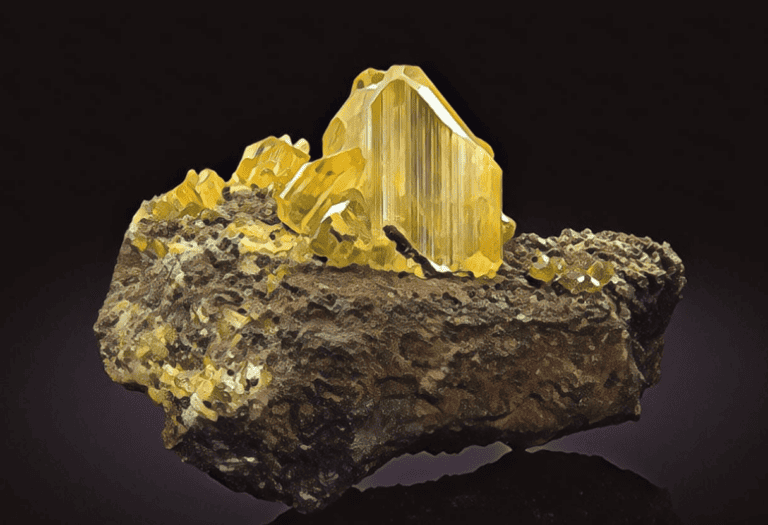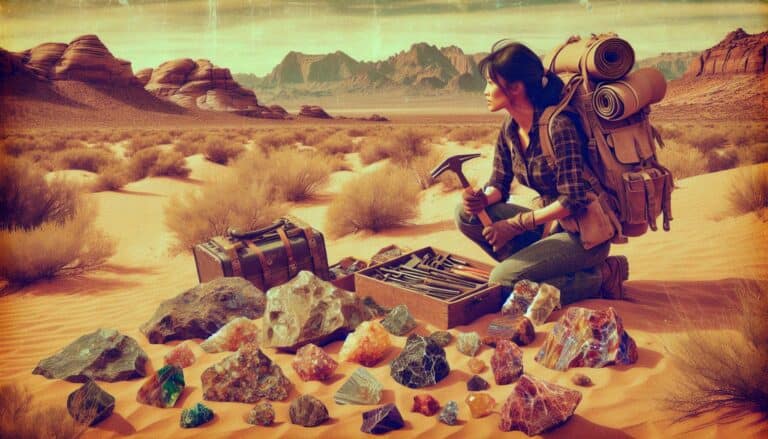Ready to uncover the hidden treasures of Louisiana’s landscapes?
You’re in for a treat as the Bayou State isn’t just about jazz and gumbo—it’s a rockhound’s paradise, too! From the rolling hills in the north to the coastal plains in the south, Louisiana offers a variety of locales where you can dig into the earth’s natural bounty.
Whether you’re a seasoned rockhound or just starting out, you’ll find something to pique your interest. You might come across petrified wood, quartz crystals, or even the elusive agate.
So grab your gear and let’s explore the top spots where Louisiana’s geological wonders await your discovery.
Louisiana’s diverse terrain offers rockhounding sites rich in petrified wood, quartz, and agate. Key locations include Kisatchie National Forest for quartz, Baton Rouge for agates, and Toledo Bend for petrified wood. Monroe’s Ouachita River is ideal for fossils and geodes. Always check local regulations and obtain permissions.
Louisiana Rockhounding Locations
Embark on a geological adventure to unearth Louisiana’s hidden gems. You’ll find diverse locales ranging from the pine-covered hills to the alluvial plains of the Mississippi River, each with its unique offerings.
Kisatchie National Forest stands out as a premier destination. Here, the sandstone outcrops shelter quartz crystals amid the lush greenery. While you’re immersed in nature’s tranquility, keep your eyes peeled for the distinct shape of these translucent beauties.
Heading toward the Gulf of Mexico, the gravel beds along riverbanks and streams are fertile grounds for rockhounds. Baton Rouge’s Mississippi River offers a great spot where water and time have unearthed a variety of stones, including exquisite agates.
For a chance to add petrified wood to your collection, venture to the Toledo Bend Reservoir. Its shores are ripe for exploration as constant erosion brings new treasures to the surface. Be alert, you might just spot a piece of ancient forest turned to stone.
North Louisiana isn’t left out of the rockhounding scene. Monroe’s Ouachita River is another hub where sedimentary layers hide fossilized specimens and geodes awaiting discovery. Here’s what you might find:
| Location | Possible Finds |
|---|---|
| Kisatchie Forest | Quartz Crystals |
| Baton Rouge | Agates, Common Minerals |
| Toledo Bend | Petrified Wood |
| Monroe’s Ouachita | Fossils, Geodes |
Remember, it’s vital to respect property rights and secure permissions where necessary. Some areas may be off-limits or require a permit for collecting. Always check local regulations before starting your search. With the right approach, you’re set for an experience that’s not just about the finds but also about connecting with Louisiana’s rich and vibrant landscape.
What Gemstones are Found in Louisiana?

Louisiana’s fertile grounds offer more than just a rich cultural tapestry; they’re also a haven for precious gemstones and interesting mineral finds. When you think of rockhounding in the Pelican State, imagine the thrill of unearthing a wide variety of stones each with its own unique allure.
Amethyst, the captivating purple quartz, is a rare find but is occasionally spotted in Louisiana. Its vibrant hues can range from a light pinkish-violet to a deep, royal purple. Though amethyst deposits are not prolific, seasoned rockhounds may come across these gems in areas with past volcanic activity.
Calcite crystals are another notable find in Louisiana. These can be located in the northern parts of the state, mainly within sedimentary rocks. Their transparent to opaque appearance and diverse range of colors make calcite a popular collectible.
Agate is found in gravel beds and water-worn pebbles along rivers and old marine terraces. Its banded patterns are a signature draw for enthusiasts and casual collectors alike. The cut and polished forms reveal the intricate inner beauty of these stones.
Petrified wood, which is fossilized remains of terrestrial vegetation, holds a unique place in Louisiana’s geological diversity. While not a gemstone in the traditional sense, it carries significant appeal due to its historical and visual aspects. Toledo Bend Reservoir and the surrounding areas are prime locations to find these specimens, some of which display opalized forms that glisten in the right light.
Keep in mind that the conditions in various locales affect the kinds of minerals and gemstones you’ll encounter. For instance, in regions with more sedimentary rocks, like shale and limestone, you’re more likely to stumble upon fossils and concretions. Similarly, areas rich in igneous and metamorphic rocks may yield a broader array of crystalline formations.
Remember that some areas may be off-limits for collecting. Always ensure you have permission to explore and collect gemstones, and follow the regulations put in place to preserve these natural wonders for generations to come.
What Sedimentary Rocks You Can Find in Louisiana?

Louisiana, with its diverse geological landscape, is home to a variety of sedimentary rocks. Limestone, for instance, is prevalent due to the marine environments that once existed in the region. Often rich in fossils, limestone from Louisiana provides a window into ancient sea life and conditions.
Sandstone is another sedimentary rock you’ll encounter. It’s formed from particles of sand compacted and cemented over time. In Louisiana, the sandstone is often colored in hues of tan and brown, indicative of the minerals within and the conditions during formation.
You might also find shale, a fine-grained sedimentary rock composed mostly of mud, silt, and clay. As you explore areas where water has flowed or lakes have dried up, keep your eyes peeled for this rock, as it’s a common find in such sedimentary basins.
Additionally, the state offers an abundance of flint and chert. Renowned for their use in tools and weapons by Indigenous peoples, these rocks are hard, fine-grained, and typically found in nodules or layers within limestone and chalk. While hunting for these, you may also come across various other minerals embedded within the sedimentary rock.
It’s key to remember that sedimentary rocks can change and form through the process of diagenesis. External factors such as temperature, pressure, and mineral-rich fluids can alter these rocks long after they’ve been laid down, ensuring that every find has a unique story.
Exploring Louisiana’s rich sedimentary rock deposits is an invitation to uncover the ancient past. Each specimen not only reveals the conditions at the time of its formation but can also clue you in about the broader geological history of the area. Keep an eye on the ground, as the state’s waterways, cliffs, and quarries might just present you with your next impressive find.
What Metamorphic Rocks are found in Louisiana?
Venturing into the world of metamorphic rocks in Louisiana, you’ll find that the variety is not as extensive as in regions known for dynamic geological activity. However, Louisiana does have its share of metamorphic surprises. Slate and schist, both formed from the metamorphism of shale, occasionally surface among the state’s geological formations. While not abundant, these rocks hint at ancient pressures and temperatures that once acted upon the region.
Metamorphic minerals like serpentine, talc, and soapstone also make appearances in the state. Typically found in areas where tectonic activity has introduced or altered existing minerals, these are signs of the earth’s ever-changing dynamics. Your prospecting might not yield extensive quantities, but the thrill of uncovering these metamorphic treasures can be gratifying.
- Slate: Often associated with old stream beds
- Schist: Look for sparkling sheets or flakes
- Serpentine: Lustrous, greenish tint
- Talc: Softest mineral, can be scratched by a fingernail
- Soapstone: Feels soapy to the touch, often gray or green
When exploring for metamorphic rocks in Louisiana, research and local knowledge are key. Rockhounding guides and geological surveys can provide crucial information on where these rocks might be located. Remember that metamorphic rocks often tell a story of transformation, so seek out regions where the conditions have been right for such change.
Whether it’s the seasoned rockhound or the curious novice, Louisiana’s metamorphic selection offers a unique glimpse into the state’s lesser-known geological facets. While your primary finds are likely to be sedimentary rocks, don’t discount the potential discoveries lying in wait, ready to shine a light on Louisiana’s hidden geologic tales.
What Igneous Rocks can You Find in Louisiana?
Exploring Louisiana’s geology uncovers a few surprises, particularly when it comes to igneous rocks. Igneous rocks are formed from the cooling and solidification of magma or lava, and while Louisiana is not known for its volcanic activity, there are still some notable finds.
Your adventure might lead you to discover basalt and granite, two of the most common igneous rocks. In Louisiana’s case, these rocks are not native to the current geological landscape but are instead brought in from other locations by the Mississippi River. Over time, waters have transported these rocks as erosional debris from far-away volcanic sites.
When you’re rockhounding in Louisiana for igneous rocks, here’s what you’re more likely to find:
- Basalt clasts within sedimentary deposits
- Granite boulders or pebbles alongside riverbeds
- Pumice fragments, though rare, might be uncovered near river deltas
The Tertiary’s volcanic activity far out west once spewed out material that eventually made its way to Louisiana. Interestingly, you’ll notice these igneous rocks are often rounded and polished, a testament to their long journey being tumbled along riverbeds.
Although Louisiana isn’t the first state you’d think of for igneous rock deposits, it definitely provides a unique setting to find them. The key to a successful hunt is to search where rivers have cut deeply into the earth or along the coast where ancient waterways have deposited their loads.
Focus your search on gravel pits, construction sites, or naturally eroded areas, always remembering to get permission if the area is privately owned. These locations can yield exciting finds for the patient and observant rockhound.
Remember, while Louisiana may not provide the dramatic igneous rock formations as seen in the western United States, the subtle treasures that you do find offer a fascinating link to volcanic activity far beyond the state’s borders. Keep your eyes peeled and your rock hammer ready for whenever you might strike upon igneous fragments on your Louisiana rockhounding escapades.
Panning for Gold in Louisiana
Louisiana may not be the first state that pops into your mind when you think of gold panning, but you’ll be surprised to know that there’s still gold to be found in its waters. Unlike the gold rushes of California and Alaska, Louisiana’s gold mining history is subdued, with only a few small discoveries reported in the past. However, that doesn’t mean you won’t find any of the lustrous metal while exploring the state’s rivers and creeks.
When looking for spots to pan for gold in Louisiana, your best bet is to visit areas known for historic placer mining. Streams such as the Sabine River have been noted for minor gold findings. While the quantities may not be large, the possibility of finding something can be an exciting prospect.
Your gold panning adventure in Louisiana should include visits to public lands where panning is allowed. Always remember to check the legal requirements before you start. Some areas may require permits, and there could be restrictions on the types of tools you can use. You don’t want a simple oversight resulting in a fine or worse, ruining your rockhounding experience.
For those looking to pan for gold in Louisiana, here are a few practical tips:
- Research locations where gold has been historically found.
- Always obtain permission if your chosen spot is on private land.
- Use proper panning techniques to increase your chances of finding gold.
- Consider joining a local rockhounding group for guidance and company.
The thrill of discovering gold, even in small flakes, is a unique experience that connects you with the prospectors of the past. Although Louisiana’s rivers may not yield the mother lode, you’ll gain invaluable panning skills and perhaps walk away with your own tiny treasure trove reflecting Louisiana’s subtle yet sparkling gold history.
Rocks and Minerals Found in Louisiana
Louisiana’s landscape is not only rich with cultural history but also with geological treasures waiting for avid rockhounds like you to uncover. Petrified wood, a prime example of such treasures, is abundant and can tell a fascinating story of the state’s ancient past. Petrified wood is actually ancient wood that has been completely transitioned to stone by the process of permineralization, and it can be commonly found in the Tunica Hills area, offering an exciting find for rockhounds.
In your exploration, you may encounter opal. Though rarer in Louisiana, when you do find opal, it’s often of the variety known as Louisiana Opal or sand opal. This type of opal, distinguished by its fiery play of color, can sometimes be discovered in the Vernon Parish.
If you’re seeking a wide variety of finds, consider visiting gravel bars along Louisiana’s rivers and streams. Here, you’re likely to find a mix of minerals including quartz crystals, common in the state’s alluvial deposits. The rivers of Louisiana churn up an array of rocks and minerals, making every visit a potential surprise package of geological wonders.
Don’t overlook the smaller treasures – garnets and agate often hide in the overlooked gravel and sediment. Garnets can typically be found in a range of colors, and agates are known for their beautiful, banded patterns. For the best chance of finding these smaller gems, pay special attention to the sediment layers when you’re sifting through gravel.
Remember, safety should always be your top priority. Ensure you’re equipped with the proper tools and attire for rockhounding. A good rock hammer, gloves, and sturdy shoes are essential. Moreover, always make sure to respect the land you’re collecting on; adhere to the local guidelines and always obtain permission when necessary.
Happy rockhounding as you continue to explore the geological diversity of Louisiana, a state that’s more than meets the eye. With each stone turned, you’re likely to unveil a piece of history that’s as enriching as it is thrilling to find.
Where Can I Find Fossils in Louisiana?
When your rockhounding adventure steers toward a quest for ancient treasures, Louisiana’s fossil locales offer a glimpse into prehistoric life that once thrived here. Fossils in Louisiana are predominantly found in areas where sedimentary rocks such as sandstone, shale, and clay are exposed.
Greenwood in Caddo Parish is a favorite spot where the Cane River Formation is exposed. Here, you’ll find a variety of marine fossils, including petrified wood and gastropods. Make sure you’re on the lookout for the well-preserved shark teeth that tell tales of ancient seas.
In Bossier Parish, the Red River exposes fossiliferous sediments ripe for exploration. This site is particularly known for Pleistocene fossils, which include megafauna such as mastodon and bison bones. For those interested in vertebrate paleontology, this is the location to add to your must-visit list.
Don’t overlook stream beds and gravel pits throughout the state, as these are excellent spots for amateur paleontologists. They’re often rich in fossil fragments and shells. One tip is to go after a heavy rain, which can unbury new finds and refresh the hunting grounds.
It’s critical to respect property rights and always obtain permission before fossicking on private lands. Public lands often have rules and regulations you’ll need to follow to ensure that these historical sites remain undisturbed for future generations.
As with any rockhounding activity, be equipped with the proper tools – a good-quality shovel, a sieve for sifting, and sturdy bags to carry your finds. It’s also wise to bring along a field guide to help identify your fossil discoveries and understand the significance of each piece.
Remember to document the location and context of your finds, as this information can be invaluable to understanding the geological history of Louisiana. Whether you’re a seasoned fossil hunter or just starting out, the thrill of unearthing a piece of the past is an experience like no other.
Louisiana Rockhounding Laws & Regulations
When you set out on your rockhounding adventure in Louisiana, it’s crucial to understand the laws and regulations that govern the collection of minerals, gems, and fossils. Your awareness and compliance will ensure a hassle-free and enjoyable experience.
Public Lands offer different levels of accessibility for rockhounding. National Forests generally allow for the collection of small quantities of rocks and minerals for personal use without a permit. However, collecting in Louisiana’s State Parks is much more restricted. You’ll need to check rules specific to each park before removing any material.
Private Property is abundant in Louisiana, and obtaining permission from the landowner is essential before rockhounding. This is not only respectful but required by law. Unauthorized collecting on private land can lead to trespassing charges. Always ask first – most landowners appreciate your consideration and may grant you access.
When rockhounding on any land, be it public or private, always follow the Leave No Trace principles. This means:
- Taking out everything you bring in
- Disturbing the environment as little as possible
- Filling in any holes you dig
In Louisiana, Cultural Artefacts and Fossils have special protections. It’s against the law to collect artefacts from any state-owned land, including a prehistoric site or any area that may contain archaeological value. Vertebrate fossils, such as dinosaur bones, are considered state property and cannot be collected without proper authorization.
Moreover, collecting methods matter. Use of heavy equipment is generally frowned upon and in some cases, prohibited, without a land disturbance permit. Hand tools like shovels, picks, and sieves are your go-to tools.
Rockhounding Tips for Beginners in Louisiana
Gearing Up: Essential Tools for Rockhounding
As a beginner in the fascinating world of rockhounding, you’ll need to gear up with some essential tools. Quality matters when it comes to selecting your equipment. Here’s a rundown of items that should be in your rockhound toolkit:
- Rock hammer: An indispensable tool for breaking and splitting rocks.
- Chisels and picks: Used in combination with a rock hammer for precise work.
- Safety goggles: Protect your eyes from flying rock fragments.
- Sturdy gloves: To keep your hands safe and clean.
- Bucket or backpack: Ideal for carrying your finds.
- Field guide: To help you identify various rocks and minerals.
- GPS device or map: For easy navigation of the terrain you’re exploring.
Invest in durable gear that can withstand the rugged outdoors. Don’t forget to pack enough water to stay hydrated and some snacks to keep your energy up.
Safety Tips While Rockhounding
Rockhounding is an adventurous activity, but like all treks into nature, it demands attention to safety. Follow these tips to ensure a safe and enjoyable experience:
- Always tell someone where you’re going and when you expect to return.
- Check the weather forecast before heading out and prepare accordingly.
- Wear appropriate clothing and footwear for rough terrain.
- Stay aware of your surroundings; wildlife and potential hazards like loose rocks and steep slopes can pose risks.
- Carry a first-aid kit for unforeseen injuries.
Being vigilant about your safety is key when rockhounding in Louisiana’s diverse landscapes.
Legal Guidelines for Rockhounding Enthusiasts
To avoid legal missteps while rockhounding, stay informed about the dos and don’ts. Here are some critical legal guidelines you should know:
- Familiarize yourself with the local laws and regulations—what’s allowed and what isn’t.
- Always get permission when you plan to rockhound on private property.
- Respect designation of areas: Some may be off-limits to protect the natural environment or cultural sites.
- Refrain from using motorized equipment which can be restricted or prohibited in certain areas.
- Be aware of the size and quantity limits for collecting rocks, minerals, and fossils.
Sticking to these legal guidelines will help protect the hobby for everyone and safeguard Louisiana’s geological and cultural heritage. Remember that your actions can contribute to the preservation of rockhound sites for future generations.
Conclusion: Louisiana Rockhounding Map
Embarking on your rockhounding adventure in Louisiana promises a treasure trove of geological wonders.
Armed with the right tools and mindful of safety and legality, you’re set to explore the state’s rich offerings. Remember, your actions help preserve these natural sites for fellow enthusiasts and future generations.
Happy hunting, and may your efforts yield spectacular specimens that add to the allure of your collection.







